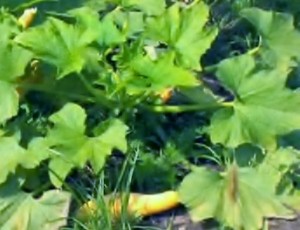
 I have not yet had a chance to try this tip, but heard it around the time I vowed never to plant squash again due to hating to see it destroyed by the nasty squash vine borer! I would love for an intrepid TF reader to try it out and tell me if it works. Next time I plant squash, I will try it out.
I have not yet had a chance to try this tip, but heard it around the time I vowed never to plant squash again due to hating to see it destroyed by the nasty squash vine borer! I would love for an intrepid TF reader to try it out and tell me if it works. Next time I plant squash, I will try it out.
The squash vine borer is a very insidious moth that feeds on squash plants. You can tell it attacked your squash when you can see that the stem of the plant itself has been destroyed and gutted out by a disgusting fat white grub. Apparently, the squash vine borer comes up from the soil through the root structure.
Therefore, a very simple thing that will pretty much guarantee that the bugger will leave the plant alone is to plant the seedling inside a large jar or can, and then plant the can inside the garden bed itself! Or you don't even have to do that if you don't want to, for squash is one of the sorts of plants that will do well in containers due to small root structure - always be sure you have at least one male and female, though.
This should see you have no pest problems for the entire season!
Add your voice! Click below to comment. ThriftyFun is powered by your wisdom!
I had also decided to never plant squash again until I read your post. I'm going to try this. I love fried squash with string beans and both come in about the same time.
The method you propose is simple enough and I wish it were true. But, according to:
PenState College Of Agricultural Sciences
Entomology Department
The borer enters the vine via a different route:
Squash Vine Borer
Life Cycle
The squash vine borer overwinters as a pupa. In Pennsylvania adults emerge in mid-to-late June. Moths will oviposit throughout July and August. Eggs are oviposited singularly or in small groups on the stem immediately above the ground surface. Eggs take a week to 10 days to hatch. Larvae enter the stem immediately, leaving a small hole surrounded by frass as the point of entry.
The larvae will feed on the plant for approximately 4 weeks by continuing to tunnel through the stem of the plant. When they are ready to pupate the larvae will burrow into the soil and spin a cocoon. In Pennsylvania the squash vine borer will only have one generation a year. In many southern states two generations are common.
Thanks for the source. Believe it or not I did a rudimentary google search before posting this & did not find anything re subject! I must have been looking in the wrong place!
I wonder if it would be possible to somehow cover the stem /entrance of the plant with cloth or plastic? Since the article says the bug comes in at that point...
Add your voice! Click below to comment. ThriftyFun is powered by your wisdom!